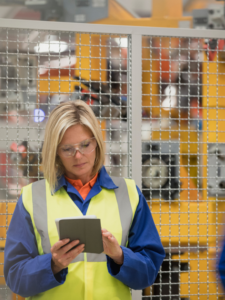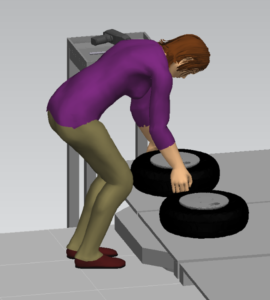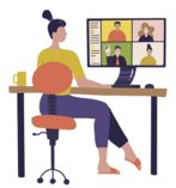Ever thought of doing yoga at work? It’s easier and more beneficial than you think. Here’s why:
Yoga is an effective stress reducer. This may also raise morale and encourage more positive thinking. Physical benefits include increased flexibility and strength, reductions in muscle pain, tension, and fatigue, leading to the potential for increased productivity.
If the thought of rolling out your yoga mat at work sounds like a stretch, there are several poses that can be performed at your desk in a few minutes.
• Arms Extended to Sides: While seated, extend both arms laterally at shoulder height, extend wrists holding momentarily. Follow this by flexing wrists. The same wrist movements can be performed with the elbows flexed. This movement stretches the forearms and wrists, increasing blood flow.
• Shoulder Rolls: On an inhale, draw the shoulders up toward your ears and back; then down and forward on the exhale. Repeat two more times, and then reverse the direction. This exercise increases mobility in the shoulder joints and opens the chest.
• Seated Twist: On an exhale, begin to twist to your right. Place both hands on the right arm-rest for support; if you’re sitting in an armless chair, rest your right hand on the seat just behind your pelvis and your left hand on your right thigh. Allow the breath to guide you deeper into the pose by lengthening the spine with each inhale, and squeezing the belly in while deepening the twist with each exhale. Hold for 30 to 60 seconds, then switch sides.
• Chest Opener: Interlace fingers behind the back while remaining seated on a chair, pull hands away from the body to stretch the front of the shoulders and chest. Alternatively, this can be performed by grasping the rear of the seat pan on your chair to induce the same stretch. This is beneficial for counteracting the hunching forward that often occurs when working in a seated posture for extended periods of time.
• Seated Cat/Cow: While seated, on an inhale, arch your back, moving the shoulder blades toward each other, lifting the chest and moving the tailbone back. During the exhale, round your back, moving the chin towards the chest, shoulder blades apart, and tailbone forward. Continue to perform these movements at the rate of your own breathing.
• Leg Cradle: Place your outer left ankle on your right thigh. With your right hand resting on your left ankle and your left hand on your left knee, exhale and bend forward from the hip joints. Keep the spine straight as you fold forward. Fold only as far as you’re comfortable, gently stretching the deep muscles surrounding the left hip joint. Hold for 30 to 60 seconds, then change sides.
• Wide-Legged Forward Bend: Separate your knees and feet slightly wider than hip distance and place your hands on your thighs. Exhale and fold forward from the hips, keeping the spine straight. Hold for a few breaths, then slide your hands down your legs, allowing the spine to round (be careful if your chair is on wheels!). Breathe into the hip joints and enjoy the length and spaciousness along the spine. For a deeper stretch, release your hands to the floor between your feet. Hold for 30 to 60 seconds, then slowly come back up, using your leg and abdominal muscles for support.
For the full article and references, see below
—
With the minimization of variety in physical tasks required by many occupations, employees are finding themselves performing increased levels of repetitive tasks. This trend is not limited to general laborers, but also office staff. Whether work is performed on an assembly line or at a desk, the prevalence of repetitive strain injuries (RSI) is something that should not be ignored.
According to Statistics Canada (2001/2002), one in ten Canadian adults acquired a repetitive strain injury serious enough to limit their normal activities. In the United States, according to the US Department of Labor, 2010, musculoskeletal disorders account for 28% of lost-time injuries and illnesses reported by employers. Of that number, 65 percent involved backs and 32 percent involved upper extremities. In addition to this finding, it was noted that stress at work can impact an individual’s likelihood of developing an RSI. Stress at work may stem from several sources including work pace, volume, monotonous tasks, unclear job expectations and worries related to job security or the organization.
Corporate health and wellness programs have demonstrated effects such as lowered absentee rates, reduced quantity of medical claims, reduced incidence of accidents and industrial injuries, increased productivity, and lower employee turnover (Shephard, 1996). As a component of a workplace wellness program, or as a stand-alone addition to one’s workday, yoga is an effective stress reducer, which may also raise morale and encourage more positive thinking. Physical benefits include increased flexibility and strength, reductions in muscle pain, tension, and fatigue, leading to the potential for increased productivity at work.
If the thought of rolling out your yoga mat at work sounds like a stretch, there are several poses that can be performed at your desk. A full hour of committed practice is not necessary to reap the many benefits of yoga. You may find the poses presented below a good place to start while taking just minutes a day. When starting a new exercise regimen, be sure to consult with your physician, and listen to your body doing only what feels comfortable.
Arms Extended to sides: While seated, extend both arms laterally at shoulder height, extend wrists holding momentarily. Follow this by flexing wrists. The same wrist movements can be performed with the elbows flexed. This movement stretches the forearms and wrists, increasing blood flow.
Shoulder Rolls: On an inhale, draw the shoulders up toward your ears and back; then down and forward on the exhale. Repeat two more times, and then reverse the direction. This exercise increases mobility in the shoulder joints and opens the chest.
Seated Twist: On an exhale, begin to twist to your right. Place both hands on the right arm-rest for support; if you’re sitting in an armless chair, rest your right hand on the seat just behind your pelvis and your left hand on your right thigh. Allow the breath to guide you deeper into the pose by lengthening the spine with each inhale, and squeezing the belly in while deepening the twist with each exhale. Hold for 30 to 60 seconds, then switch sides.
Chest Opener: Interlace fingers behind the back while remaining seated on a chair, pull hands away from the body to stretch the front of the shoulders and chest. Alternatively, this can be performed by grasping the rear of the seat pan on your chair to induce the same stretch. This is beneficial for counteracting the hunching forward that often occurs when working in a seated posture for extended periods of time.
Seated Cat/Cow: While seated, on an inhale, arch your back, moving the shoulder blades toward each other, lifting the chest and moving the tailbone back. During the exhale, round your back, moving the chin towards the chest, shoulder blades apart, and tailbone forward. Continue to perform these movements at the rate of your own breathing.
Leg Cradle: Place your outer left ankle on your right thigh. With your right hand resting on your left ankle and your left hand on your left knee, exhale and bend forward from the hip joints. Keep the spine straight as you fold forward. Fold only as far as you’re comfortable, gently stretching the deep muscles surrounding the left hip joint. Hold for 30 to 60 seconds, then change sides.
Wide-Legged Forward Bend: Separate your knees and feet slightly wider than hip distance and place your hands on your thighs. Exhale and fold forward from the hips, keeping the spine straight. Hold for a few breaths, then slide your hands down your legs, allowing the spine to round (be careful if your chair is on wheels!). Breathe into the hip joints and enjoy the length and spaciousness along the spine. For a deeper stretch, release your hands to the floor between your feet. Hold for 30 to 60 seconds, then slowly come back up, using your leg and abdominal muscles for support.
In addition, strong postural muscles will improve one’s ability to maintain an upright seated posture. Proper alignment is achieved by maintaining parallel feet, bent knees (even when standing), engaging the lower abdomen in and up, tailbone down, lengthening from waist to underarms (without hiking shoulders to ears and sticking out the bottom of ribcage), moving the bottom of the shoulder blades towards one another, and maintaining ears above shoulders. Consider these steps your checklist to achieve great posture, try out a few poses and notice the positive effects they have on how you feel at work and beyond!
References
Capitolo, G., 2009. Yoga Break! Yoga International Magazine, Himalayan Institute.
Shephard, Roy.,. Financial Aspects of Employee Fitness Programmes, Workplace health: Employee fitness and exercise. Taylor & Francis Ltd, London: (1996).
Shields, D., 2007. Yoga as Part of Wellness in the Workplace: A Case Study. Presented at the Atlantic Networks for Prevention Research Conference, St. John’s, Canada.
Tjepkema, M., 2003. Repetitive Strain Injury. Statistics Canada Health Reports, Volume 14 (4). https://www.statcan.gc.ca/studies-etudes/82-003/archive/2003/6594-eng.pdf; retrieved February 2, 2011.
US Department of Labour, Preventing Repetitive Stress Injuries, November 9, 2010. https://stats.bls.gov/news.release/osh2.nr0.htm; retrieved March 16, 2011.


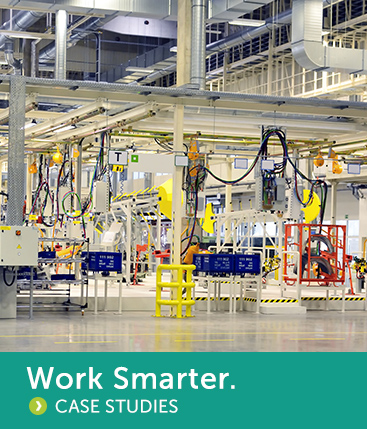




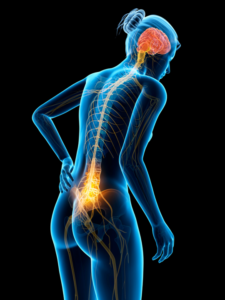

 Why Sandalwood?
Why Sandalwood?


 We are a one-stop-shop for launching job rotation for any employer from conception to implementation. Our experts tailor our services to meet the needs of our customers by collaborating with them throughout the entire process. We do not offer cookie cutter solutions for job rotation because the needs of employers vary significantly.
We are a one-stop-shop for launching job rotation for any employer from conception to implementation. Our experts tailor our services to meet the needs of our customers by collaborating with them throughout the entire process. We do not offer cookie cutter solutions for job rotation because the needs of employers vary significantly. Why Sandalwood?
Why Sandalwood?


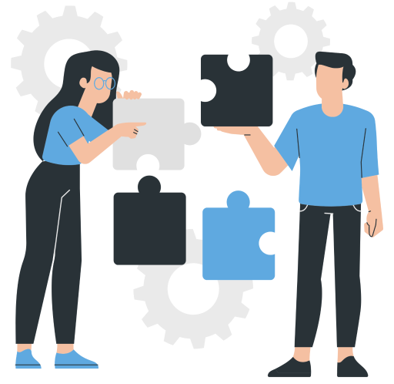
 Sandalwood is pleased to offer solutions above and beyond the traditional ergonomic assessments. With an in-depth knowledge of various digital human modelling software suites, integration and adoption to your health and safety programs has never been easier. Sandalwood is experienced in ergonomic program design as well as industry leaders in digital human modelling services. We have a diverse team that is able the leverage the results from the digital human model to provide in depth risk assessments of future designs and current state. Sandalwood is also able to pair these assessments with expertise and provide guidance on the best solution for you. Sandalwood is also on the forefront of emerging technologies and able to integrate Motion capture, Wearables, and extended or virtual reality into your ergonomic program.
Sandalwood is pleased to offer solutions above and beyond the traditional ergonomic assessments. With an in-depth knowledge of various digital human modelling software suites, integration and adoption to your health and safety programs has never been easier. Sandalwood is experienced in ergonomic program design as well as industry leaders in digital human modelling services. We have a diverse team that is able the leverage the results from the digital human model to provide in depth risk assessments of future designs and current state. Sandalwood is also able to pair these assessments with expertise and provide guidance on the best solution for you. Sandalwood is also on the forefront of emerging technologies and able to integrate Motion capture, Wearables, and extended or virtual reality into your ergonomic program.